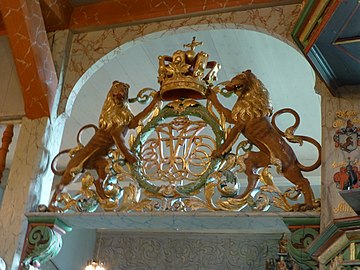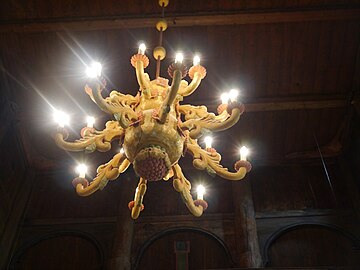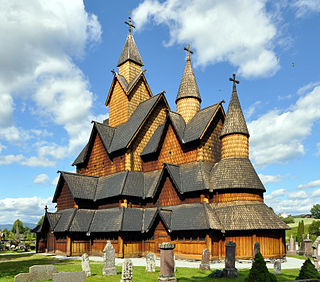
Heddal Stave Church is a parish church of the Church of Norway in Notodden Municipality in Telemark county, Norway. It is located in the village of Heddal. It is the church for the Heddal parish which is part of the Øvre Telemark prosti in the Diocese of Agder og Telemark. The wooden, triple nave stave church was built in a long church design around the year 1200 using plans drawn up by an unknown architect. The church seats about 180 people.

Vågå Church is a historic stave church. It is a parish church of the Church of Norway in Vågå Municipality in Innlandet county, Norway. It is located in the village of Vågåmo. It is the church for the Vågå parish which is part of the Nord-Gudbrandsdal prosti (deanery) in the Diocese of Hamar. The brown, wooden church was built in a cruciform design in 1627 by the architect Werner Olsen. The church seats about 250 people.

Lom Stave Church is a parish church of the Church of Norway in Lom municipality in Innlandet county, Norway. It is located in the village of Fossbergom in the traditional district of Gudbrandsdal. It is the church for the Lom parish which is part of the Nord-Gudbrandsdal prosti (deanery) in the Diocese of Hamar. The brown, wooden stave church was built around the year 1170 using plans drawn up by an unknown architect. The church seats about 350 people.

Grip Stave Church is a historic parish church of the Church of Norway in Kristiansund Municipality in Møre og Romsdal county, Norway. It is located in the now-abandoned fishing village of Grip on the small island of Grip about 14 kilometres (8.7 mi) northwest of the town of Kristiansund. It is an annex church for the Kristiansund parish which is part of the Ytre Nordmøre prosti (deanery) in the Diocese of Møre. The white, wooden church was built in a rectangular stave church style in 1470 by an unknown architect.

Hopperstad Stave Church is a historic parish church of the Church of Norway in the village of Vikøyri in Vik Municipality in Vestland county. It was historically the church for the Hopperstad parish in the Diocese of Bjørgvin. The church is currently owned by the Society for the Preservation of Ancient Norwegian Monuments. The brown, wooden stave church was built during the 12th century. The church seats about 30 people.

Røldal Stave Church is a parish church of the Church of Norway in Ullensvang Municipality in Vestland county, Norway. It is located in the village of Røldal. It is the church for the Røldal parish which is part of the Hardanger og Voss prosti (deanery) in the Diocese of Bjørgvin. The brown, wooden stave church was built in around the year 1250 using designs by an unknown architect. The church seats about 130 people and is built in a long church design. The church is a preserved historic museum, but it is still a regularly-used parish church that holds regularly scheduled worship services twice a month.

Reinli Stave Church is a preserved parish church of the Church of Norway in Sør-Aurdal Municipality in Innlandet county, Norway. It is located in the village of Reinli. It is the former church for the Reinli parish which is part of the Valdres prosti (deanery) in the Diocese of Hamar. The brown, wooden church was built in a long church design around the year 1300 using plans drawn up by an unknown architect. The church seats about 70 people.

Fåvang Stave Church is a parish church of the Church of Norway in Ringebu Municipality in Innlandet county, Norway. It is located just south of the village of Fåvang. It is the main church for the Fåvang parish which is part of the Sør-Gudbrandsdal prosti (deanery) in the Diocese of Hamar. The brown, wooden church was built in a cruciform design in the year 1630 using plans drawn up by the architect Werner Olsen. The church seats about 170 people.

Kvernes Stave Church is a former parish church of the Church of Norway in Averøy Municipality in Møre og Romsdal county, Norway. The old church sits along the Kvernesfjorden in the village of Kvernes, just to the north of the Kvernes Church, the present church for the parish. The white, wooden church was built in a rectangular stave church style sometime during the first half of the 14th century. The church seats about 200 people.
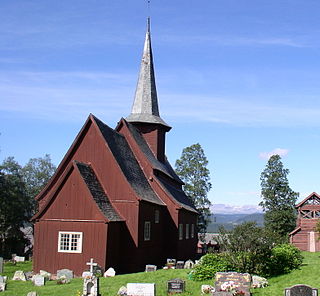
Hegge Stave Church is a 13th-century stave church in Norway. It is a parish church of the Church of Norway in Øystre Slidre Municipality in Innlandet county. It is located in the village of Hegge. It is the church for the Hegge parish which is part of the Valdres prosti (deanery) in the Diocese of Hamar. The brown, wooden church was built in a long church design around the year 1216 using plans drawn up by an unknown architect. The church seats about 150 people.

Haltdalen Church is a parish church of the Church of Norway in Holtålen municipality in Trøndelag county, Norway. It is located in the village of Haltdalen. It is the main church for the Haltdalen parish which is part of the Gauldal prosti (deanery) in the Diocese of Nidaros. The light yellow, wooden church was built in a neo-Gothic, long church style in 1881 using plans drawn up by the architects Jacob Digre and Gustav Olsen. The church seats about 300 people.
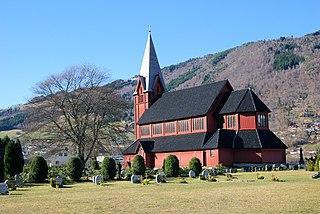
Stedje Church is a parish church of the Church of Norway in Sogndal Municipality in Vestland county, Norway. It is located in the village of Sogndalsfjøra, near the shore of the Sogndalsfjorden. It is the church for the Stedje parish which is part of the Sogn prosti (deanery) in the Diocese of Bjørgvin. The red, wooden church was built in a long church design in 1867 using plans drawn up by the architect Christian Christie. The church seats about 400 people.

Lesja Church is a parish church of the Church of Norway in Lesja Municipality in Innlandet county, Norway. It is located in the village of Lesja. It is the church for the Lesja og Lesjaskog parish which is part of the Nord-Gudbrandsdal prosti (deanery) in the Diocese of Hamar. The brown, wooden church was built in an cruciform design in 1749 using plans drawn up by the architect Ola Fredriksson Hole. The church seats about 300 people.

Fåberg Church is a parish church of the Church of Norway in Lillehammer Municipality in Innlandet county, Norway. It is located in the village of Fåberg. It is the church for the Fåberg parish which is part of the Sør-Gudbrandsdal prosti (deanery) in the Diocese of Hamar. The red, wooden church was built in a cruciform design in 1727 using plans drawn up by the architect Svend Tråseth. The church seats about 292 people.
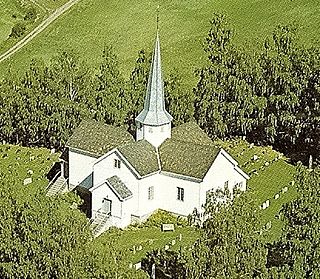
Øyer Church is a parish church of the Church of Norway in Øyer Municipality in Innlandet county, Norway. It is located in the village of Tingberg. It is the church for the Øyer parish which is part of the Sør-Gudbrandsdal prosti (deanery) in the Diocese of Hamar. The white, wooden church was built in a cruciform design in 1725 using plans drawn up by an unknown architect. The church seats about 300 people.

Øvre Rendal Church is a parish church of the Church of Norway in Rendalen Municipality in Innlandet county, Norway. It is located in the village of Bergset. It is the church for the Øvre Rendal parish which is part of the Nord-Østerdal prosti (deanery) in the Diocese of Hamar. The white, wooden church was built in an cruciform design in 1759 using plans drawn up by an unknown architect. The church seats about 280 people.

Hof Church is a parish church of the Church of Norway in Åsnes Municipality in Innlandet county, Norway. It is located in the village of Hof. It is the church for the Hof parish which is part of the Solør, Vinger og Odal prosti (deanery) in the Diocese of Hamar. The red brick church was built in a cruciform design in 1860 using plans drawn up by the architect Christian Heinrich Grosch. The church seats about 600 people.

Bagn Church is a parish church of the Church of Norway in Sør-Aurdal Municipality in Innlandet county, Norway. It is located in the village of Bagn. It is the church for the Bagn parish which is part of the Valdres prosti (deanery) in the Diocese of Hamar. The red, wooden church was built in a cruciform design in 1736 using plans drawn up by the architect Svend Tråseth. The church seats about 350 people.

Fluberg Church is a parish church of the Church of Norway in Søndre Land Municipality in Innlandet county, Norway. It is located in the village of Fluberg. It is one of the churches for the Fluberg parish which is part of the Hadeland og Land prosti (deanery) in the Diocese of Hamar. The white, wooden church was built in a cruciform design in 1703 using plans drawn up by the architect Oluf Mogensten. The church seats about 450 people.

Atrå Church is a parish church of the Church of Norway in Tinn Municipality in Telemark county, Norway. It is located in the village of Atrå. It is one of the churches for the Tinn parish which is part of the Øvre Telemark prosti (deanery) in the Diocese of Agder og Telemark. The white, wooden church was built in a long church design in 1836 using plans drawn up by the architect Hans Linstow. The church seats about 300 people.







